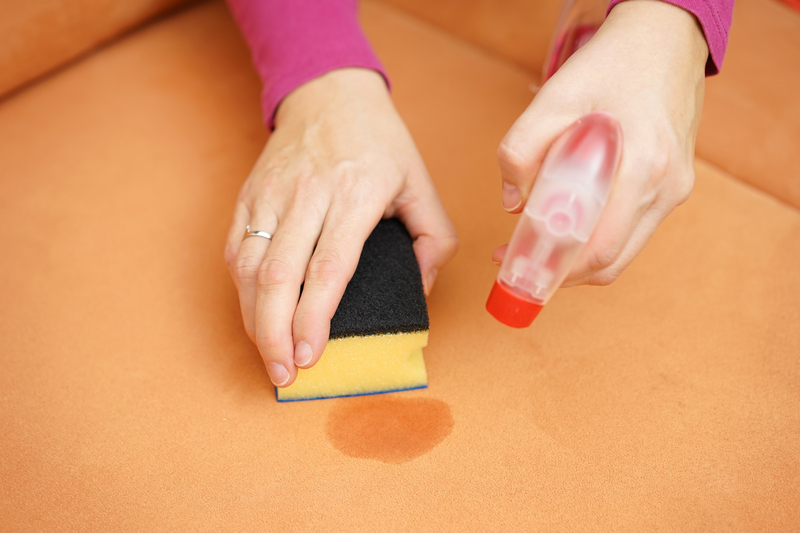Top Techniques to Keep Your Bathroom Free from Mold
Posted on 24/08/2025
Top Techniques to Keep Your Bathroom Free from Mold
A mold-free bathroom is essential not only for aesthetic reasons but also for your health. Bathrooms, with their high humidity and warm temperatures, offer the perfect conditions for mold and mildew to thrive. If you're looking for proven tips on how to prevent bathroom mold, you've come to the right place. In this comprehensive guide, we'll explore various methods to keep your bathroom free of mold and maintain a hygienic, fresh space for your family.
Why Is Mold Prevention Crucial for Bathrooms?
Mold is a type of fungus that thrives in moist, warm environments. It can cause structural damage as well as trigger health issues like allergies, asthma, and respiratory problems. Bathrooms, due to their consistent exposure to water and steam, are prime targets for mold infestation. Effective mold prevention not only protects your property but also safeguards your wellbeing.
- Health risks: Mold spores can exacerbate allergies, asthma, and cause other respiratory issues.
- Damage to surfaces: Mold can cause grout, tiles, and drywall to deteriorate, resulting in expensive repairs.
- Unpleasant odors: Mold and mildew generate persistent, musty smells that are tough to remove.
Given these risks, implementing the best techniques to prevent mold in the bathroom should be a priority for every homeowner.

Top Signs of Mold in Your Bathroom
Recognizing mold growth early is half the battle won. Here are some telltale signs your bathroom might already harbor mold:
- Discolored patches: Black, green, or brown stains on ceiling, walls, or tiles.
- Persistent musty odor: A damp, earthy smell that does not go away even with regular cleaning.
- Peeling paint or wallpaper: Dampness behind walls leads to bubbling, peeling, or cracking finishes.
- Visible fuzzy spots: Mold can appear as fuzzy, velvety patches, especially on ceilings and corners.
If you observe any of these warning signs, take immediate steps using the following top mold prevention strategies for bathrooms.
Top Techniques to Prevent Mold and Mildew in Your Bathroom
Maintaining a clean and dry bathroom environment is key. Let's delve into the most effective techniques to achieve a mold-free bathroom.
1. Boost Ventilation and Airflow
Proper ventilation is the foundation of any effective bathroom mold prevention plan. Moist air needs to escape quickly to prevent condensation on walls and ceilings.
- Install or upgrade your exhaust fan: Ensure your bathroom has an efficient exhaust fan and run it during every shower or bath, and for at least 20 minutes after.
- Open windows: If your bathroom has windows, open them during and after water use to improve airflow naturally.
- Leave doors open: When the bathroom isn't in use, keep the door ajar to allow air circulation.
Tip: Regularly clean fan vents to remove dust and debris that hinder effectiveness.
2. Control Humidity Levels
Humidity is mold's best friend. The higher the moisture in the air, the easier it is for spores to start growing.
- Use a dehumidifier: Portable dehumidifiers can help keep moisture in check, especially in small, windowless bathrooms.
- Monitor with a humidity sensor: Keep humidity levels below 50%. Invest in a digital hygrometer for an accurate reading.
- Fix leaks: Address any leaks or drips from sinks, toilets, or showers immediately to prevent constant dampness.
3. Eliminate Water Sources and Ensure Prompt Drying
The number one way to keep your bathroom free from mold is to minimize standing water and keep all surfaces as dry as possible.
- Dry shower walls and doors: Wipe down wet surfaces after every use with a squeegee or microfiber cloth.
- Hang towels and bathmats to dry: Avoid leaving soggy items on the floor or in piles. Hang them immediately in well-ventilated areas.
- Address plumbing issues: Repair any leaks under sinks, around toilet bases, or in showers to eliminate hidden sources of moisture.
- Regularly check caulking and seals: Reseal or recaulk as needed to prevent water seepage behind tiles and around tubs.
4. Clean Regularly with Mold-Inhibiting Products
Frequent cleaning goes a long way in deterring mold. Use cleaners specifically designed to kill mold and mildew.
- Choose mold-fighting products: Use vinegar, hydrogen peroxide, or commercial mold removers on tiles, grout, and other surfaces.
- Focus on corners and grout: Mold loves nooks and crannies, especially between tiles and near drains. Scrub these areas weekly with a stiff brush.
- Wash shower curtains and liners: Fabric and plastic liners should be washed or replaced monthly to prevent mold buildup.
- Keep storage clean: Remove old toiletries and keep shelves wiped down and organized.
Pro tip: Make a DIY mold prevention spray using one part white vinegar, one part water, and a few drops of essential oil. Spray onto surfaces weekly as a preventative measure.
5. Upgrade Bathroom Materials and Fixtures
Preventing mold in your bathroom is easier with the right materials and finishes.
- Opt for mold-resistant paint and grout: Specialized paints and grouts contain additives that deter fungal growth. Apply them to ceilings, walls, and tile work.
- Replace old caulking: If existing caulk is cracked or stained, it may be harboring mold behind or below the surface. Remove and recaulk with a mold-resistant product.
- Install waterproof wall panels: Instead of absorbent wallboard, use waterproof alternatives specifically made for showers and wet areas.
- Upgrade to glass shower doors: Shower curtains can trap moisture; glass doors are easier to wipe down and dry quickly.
6. Store Bathroom Essentials Properly
Implementing smart storage solutions helps with air circulation and prevents moisture traps.
- Avoid overcrowding shelves: Leave enough space between bottles and items so air can circulate freely.
- Keep sponges and loofahs dry: Hang these items where they can dry fully between uses, and replace them regularly.
- Choose open shelving: Open storage promotes airflow, reducing chances of mold growth on and behind items.
7. Maintain Good Lighting
Mold prefers dark, damp environments. Letting plenty of natural light into your bathroom can inhibit mold spores from multiplying.
- Maximize sunlight: Leave blinds or curtains open when possible to allow natural light in.
- Upgrade artificial lighting: Install bright, energy-efficient LED bulbs to keep bathrooms well-lit.
Routine Maintenance for a Mold-Free Bathroom
Establishing habits for bathroom maintenance is crucial. Here's a handy checklist:
- Ventilate after every use: Run the fan or open a window after each shower or bath.
- Wipe down surfaces daily: Quickly dry all wet surfaces, especially tiles, counters, and mirrors.
- Launder linens weekly: Towels and bathmats should be washed regularly in hot water to kill spores.
- Check for leaks monthly: Inspect under sinks, behind the toilet, and around faucets for signs of leakage or moisture.
- Deep clean monthly: Scrub grout, drains, and hidden corners with a mold-fighting cleanser at least once a month.
What to Do If You Discover Mold in Your Bathroom?
Despite your best efforts, sometimes bathroom mold prevention strategies fail, and you might find mold growing. Here's what to do:
- Wear protective gear: Use gloves, a mask, and goggles to avoid coming in direct contact with spores.
- Ventilate the room: Open windows and doors to keep air moving and prevent spores from spreading to other areas.
- Remove small patches yourself: Scrub affected areas with a mold-killing solution (like diluted bleach or vinegar). Dry thoroughly afterward.
- Dispose of contaminated materials: If mold has deeply penetrated porous items (like ceiling tiles or drywall), these may need to be discarded.
- Call a professional: If the affected area is larger than 10 square feet, or if mold persists despite cleaning, consult a mold remediation professional immediately.
Effective Natural Remedies for Mold Prevention
If you prefer environmentally friendly solutions, the following natural techniques will help keep your bathroom clear of mold:
- White vinegar: Spray undiluted onto surfaces; leave for at least an hour before wiping clean.
- Baking soda: Make a paste with water and scrub onto grout and tiles for gentle yet effective cleaning.
- Tea tree oil: Add a teaspoon of tea tree oil to a cup of water, spray onto affected areas, and leave it to work its antifungal magic.
- Lemon juice: The acidic nature of lemon juice can repel mold spores and leave your bathroom smelling fresh.

Preventive Measures to Maintain a Mold-Free Bathroom
In essence, keeping your bathroom mold-free boils down to two main things: minimizing moisture and maximizing cleanliness.
- Regularly inspect and repair grout and seals: Don't allow gaps for water to seep into walls or floors.
- Educate your family: Teach everyone about the importance of ventilation, wiping down surfaces, and hanging up towels.
- Invest in quality: Choose high-quality bathroom fixtures and building materials designed for humidity resistance.
Conclusion: Your Mold-Free Bathroom Awaits
Maintaining a mold-free bathroom might seem like a daunting task, but with these effective mold prevention techniques, you'll enjoy a fresher, healthier, and more beautiful space. Remember, proactive steps like boosting ventilation, controlling humidity, cleaning regularly, and using mold-resistant materials are key. By adopting these habits and quick fixes, you will keep your bathroom constantly free from mold and mildew -- ensuring long-term protection for both your home and your family's health.
If you're serious about preventing bathroom mold, start applying these top methods today and make mold problems a thing of the past!
For more tips on bathroom maintenance and home cleanliness, bookmark this guide and revisit regularly for updates on the latest mold-fighting techniques.




